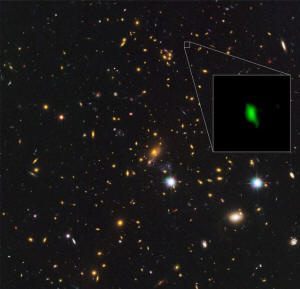|
Oxygen presence in distant galaxy sheds
light on early universe
 Send a link to a friend
Send a link to a friend
[May 17, 2018]
By Will Dunham
WASHINGTON (Reuters) - After detecting a whiff of oxygen, astronomers
have determined that stars in a faraway galaxy formed 250 million years
after the Big Bang -- a rather short time in cosmic terms -- in a
finding that sheds light on conditions in the early universe.
Their research, published on Wednesday, provides insight into star
formation in perhaps the most distant galaxy ever observed. The
scientists viewed the galaxy, called MACS1149-JD1, as it existed roughly
550 million years after the Big Bang, which gave rise to the universe
about 13.8 billion years ago. |

A galaxy located 13.28 billion light-years away is giving scientists new
insight into the early history of the universe, with the detection of
the oldest-known evidence of oxygen. This Hubble Space Telescope image
shows the galaxy cluster MACS J1149.5+2223 and the inset image shows the
galaxy MACS1149-JD1, with the detected oxygen distribution in green,
observed with the Atacama Large Millimeter/submillimeter Array (ALMA),
an astronomical interferometer of radio telescopes in the Atacama desert
of northern Chile. The image was released May 16, 2018. Courtesy ALMA
(ESO/NAOJ/NRAO), NASA/ESA Hubble Space Telescope, W. Zheng (JHU), M.
Postman (STScI), the CLASH Team, Hashimoto et al/Handout via REUTERS |
|
Light emitted by MACS1149-JD1 traveled 13.28 billon light years
before reaching Earth. Looking across such distances lets
scientists peer back in time. A light year is the distance light
travels in a year, 5.9 trillion miles (9.5 trillion km).
The detection of oxygen in MACS1149-JD1 was particularly
instructive. The universe initially was devoid of elements such
as oxygen, carbon and nitrogen, which were first created in the
fusion furnaces of the earliest stars and then spewed into
interstellar space when these stars reached their explosive
deaths.
The presence of oxygen showed that an even earlier generation of
stars had formed and died in MACS1149-JD1 and that star
formation in that galaxy began about 250 million years after the
Big Bang when the universe was only about 2 percent of its
current age, the researchers said.
The oxygen in MACS1149-JD1 was the most distant ever detected.
"Prior to our study, there were only theoretical predictions of
the earliest star formation. We have for the first time observed
the very early stage of star formation in the universe," said
astronomer Takuya Hashimoto of Osaka Sangyo University in Japan.
The study marked another step forward as scientists hunt for
evidence of the first stars and galaxies that emerged from what
had been total darkness in the aftermath of the Big Bang, a time
sometimes called "cosmic dawn."
"With these observations, we are pushing back the limit of the
observable universe and, therefore, we are coming closer to the
cosmic dawn," University College London astronomer Nicolas
Laporte said, adding that computer simulations suggest that the
first stars appeared around 150 million years after the Big
Bang.
The researchers confirmed the distance of the galaxy with
observations from ground-based telescopes in Chile and
reconstructed the earlier history of MACS1149-JD1 using infrared
data from orbiting telescopes.
The research was published in the journal Nature.
(Reporting by Will Dunham; Editing by Sandra Maler)
[© 2018 Thomson Reuters. All rights
reserved.] Copyright 2018 Reuters. All rights reserved. This material may not be published,
broadcast, rewritten or redistributed.
Thompson Reuters is solely responsible for this content.

|
|
|







